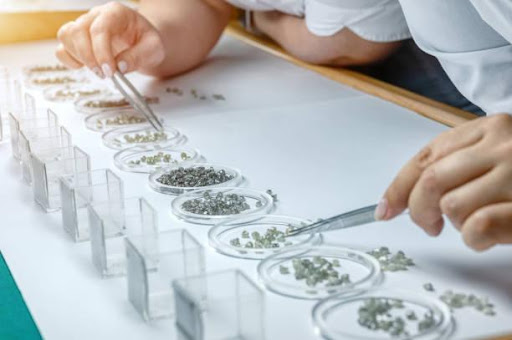
Choosing a diamond is not as simple as picking one that looks pretty. When shopping for diamonds, you have to consider many factors, such as cut and shape. But one of the most important considerations when choosing a diamond is carat weight. A diamond’s price is influenced by 4 C’s: cut, clarity, color and carat (size).
Carat is a unit of weight, but it's most commonly used to measure the size of diamonds. One carat is equal to 200 milligrams. For example, if you have a diamond that weighs 1/2 carat (100 mg), your diamond would be half the size of another diamond with a full carat (200 mg). The word "carat" comes from the ancient Greek word keration meaning “horn” and refers to how much weight this precious stone was worth—a horn was used as an ancient currency in some cultures. Today, caratels are still made from horn.
Diamonds are measured according to their proportion of mass; for example: a 1-carat round-cut diamond has 100% more surface area than an equivalent 0.75-carat brilliant round-cut diamond with no wasted space inside it at all!
The 4C’s of diamond quality are Cut, Color, Clarity, and Carat.
Cut is a measure of how well a diamond has been cut in order to maximize its brilliance and fire. A diamond with good cut reflects light across the surface of its facets in such a way that it produces sparkle; the higher-quality stones will have more sparkle than lower-quality ones.
Color is an indication of how much color is present in the stone; this can range from completely clear (D-F diamonds) to entirely yellowish or brownish (H-I diamonds). The less color present in your stone, the more valuable it will be considered by most people buying jewelry; however, this isn't always true—the tone of color can make some stones appear brighter or warmer than others even if they're rated differently on the GIA scale.
Clarity measures how many flaws there are within each stone; these flaws may be visible as "inclusions" or "blemishes" under magnification but would be unnoticeable when looking at them directly with your eyesight alone (and thus we use magnification tools like loupe glasses). The fewer flaws within each stone means that it's going to be rarer and thus more valuable than those with lots of imperfections!
Choosing the right carat is crucial to creating a beautiful diamond ring. If you’re buying your first diamond, or if you want to add more carats to your existing piece, it can be intimidating.
Fortunately, there are a few guidelines that will help you choose the right carat:
When choosing a diamond carat, it’s important to consider all of the factors. First, you need to understand what a carat means and how it affects the price. Second, think about how much you are willing to spend on your future ring and what kind of quality level fits your budget. Finally, when purchasing diamonds from various vendors make sure they will stand behind their products with warranties or guarantees so there aren't any surprises down the road!
Sell your diamonds with ease with Diamond Registry’s comprehensive approach and vast global industry connections to help you find the best buyer for your diamond fast. Visit www.diamondregistry.com/sell-your-ring to take your first step to fast, easy and reliable way of selling your diamond.
Want to check and calculate diamond per carat instantly? Go to DR’s diamond price calculator to know how. Reliable and trusted carat calculator in the diamond industry since!

